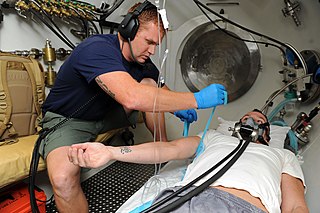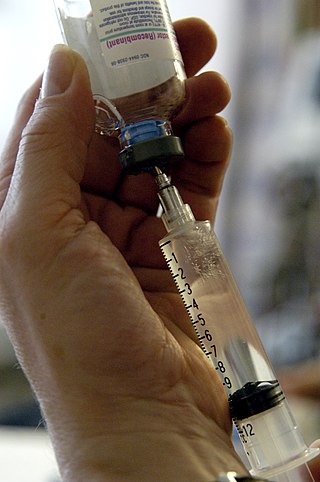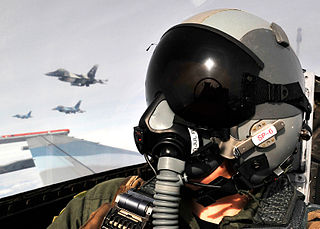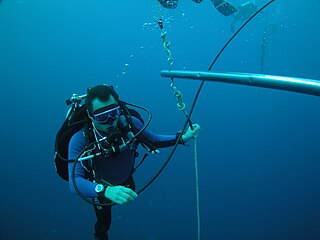Related Research Articles

Decompression sickness is a medical condition caused by dissolved gases emerging from solution as bubbles inside the body tissues during decompression. DCS most commonly occurs during or soon after a decompression ascent from underwater diving, but can also result from other causes of depressurisation, such as emerging from a caisson, decompression from saturation, flying in an unpressurised aircraft at high altitude, and extravehicular activity from spacecraft. DCS and arterial gas embolism are collectively referred to as decompression illness.

An air embolism, also known as a gas embolism, is a blood vessel blockage caused by one or more bubbles of air or other gas in the circulatory system. Air can be introduced into the circulation during surgical procedures, lung over-expansion injury, decompression, and a few other causes. In flora, air embolisms may also occur in the xylem of vascular plants, especially when suffering from water stress.

Barotrauma is physical damage to body tissues caused by a difference in pressure between a gas space inside, or contact with, the body and the surrounding gas or liquid. The initial damage is usually due to over-stretching the tissues in tension or shear, either directly by an expansion of the gas in the closed space or by pressure difference hydrostatically transmitted through the tissue. Tissue rupture may be complicated by the introduction of gas into the local tissue or circulation through the initial trauma site, which can cause blockage of circulation at distant sites or interfere with the normal function of an organ by its presence. The term is usually applied when the gas volume involved already exists prior to decompression. Barotrama can occur during both compression and decompression events.
Decompression Illness (DCI) comprises two different conditions caused by rapid decompression of the body. These conditions present similar symptoms and require the same initial first aid. Scuba divers are trained to ascend slowly from depth to avoid DCI. Although the incidence is relatively rare, the consequences can be serious and potentially fatal, especially if untreated.
In-water recompression (IWR) or underwater oxygen treatment is the emergency treatment of decompression sickness (DCS) by returning the diver underwater to help the gas bubbles in the tissues, which are causing the symptoms, to resolve. It is a procedure that exposes the diver to significant risk which should be compared with the risk associated with the available options and balanced against the probable benefits. Some authorities recommend that it is only to be used when the time to travel to the nearest recompression chamber is too long to save the victim's life, others take a more pragmatic approach, and accept that in some circumstances IWR is the best available option. The risks may not be justified for case of mild symptoms likely to resolve spontaneously, or for cases where the diver is likely to be unsafe in the water, but in-water recompression may be justified in cases where severe outcomes are likely if not recompressed, if conducted by a competent and suitably equipped team.
Dysbarism refers to medical conditions resulting from changes in ambient pressure. Various activities are associated with pressure changes. Underwater diving is the most frequently cited example, but pressure changes also affect people who work in other pressurized environments, and people who move between different altitudes.
Diving disorders, or diving related medical conditions, are conditions associated with underwater diving, and include both conditions unique to underwater diving, and those that also occur during other activities. This second group further divides into conditions caused by exposure to ambient pressures significantly different from surface atmospheric pressure, and a range of conditions caused by general environment and equipment associated with diving activities.

Underwater diving, as a human activity, is the practice of descending below the water's surface to interact with the environment. It is also often referred to as diving, an ambiguous term with several possible meanings, depending on context. Immersion in water and exposure to high ambient pressure have physiological effects that limit the depths and duration possible in ambient pressure diving. Humans are not physiologically and anatomically well-adapted to the environmental conditions of diving, and various equipment has been developed to extend the depth and duration of human dives, and allow different types of work to be done.

The Armstrong limit or Armstrong's line is a measure of altitude above which atmospheric pressure is sufficiently low that water boils at the normal temperature of the human body. Exposure to pressure below this limit results in a rapid loss of consciousness, followed by a series of changes to cardiovascular and neurological functions, and eventually death, unless pressure is restored within 60–90 seconds. On Earth, the limit is around 18–19 km above sea level, above which atmospheric air pressure drops below 0.0618 atm. The U.S. Standard Atmospheric model sets the Armstrong pressure at an altitude of 63,000 feet (19,202 m).

In underwater diving, ascending and descending is done using strict protocols to avoid problems caused by the changes in ambient pressure and the hazards of obstacles near the surface such as collision with vessels. Diver certification and accreditation organisations place importance on these protocols early in their diver training programmes. Ascent and descent are historically the times when divers are injured most often when failing to follow appropriate procedure.

The decompression of a diver is the reduction in ambient pressure experienced during ascent from depth. It is also the process of elimination of dissolved inert gases from the diver's body which accumulate during ascent, largely during pauses in the ascent known as decompression stops, and after surfacing, until the gas concentrations reach equilibrium. Divers breathing gas at ambient pressure need to ascend at a rate determined by their exposure to pressure and the breathing gas in use. A diver who only breathes gas at atmospheric pressure when free-diving or snorkelling will not usually need to decompress, Divers using an atmospheric diving suit do not need to decompress as they are never exposed to high ambient pressure.
Altitude decompression or hypobaric decompression is the reduction in ambient pressure below the normal range of sea level atmospheric pressure. Altitude decompression is the natural consequence of unprotected elevation to altitude, while hypobaric decompression is due to intentional or unintentional release of pressurisation of a pressure suit or pressurised compartment, vehicle or habitat, and may be controlled or uncontrolled, or the reduction of pressure in a hypobaric chamber.

The practice of decompression by divers comprises the planning and monitoring of the profile indicated by the algorithms or tables of the chosen decompression model, to allow asymptomatic and harmless release of excess inert gases dissolved in the tissues as a result of breathing at ambient pressures greater than surface atmospheric pressure, the equipment available and appropriate to the circumstances of the dive, and the procedures authorized for the equipment and profile to be used. There is a large range of options in all of these aspects.

Decompression in the context of diving derives from the reduction in ambient pressure experienced by the diver during the ascent at the end of a dive or hyperbaric exposure and refers to both the reduction in pressure and the process of allowing dissolved inert gases to be eliminated from the tissues during this reduction in pressure.

Decompression theory is the study and modelling of the transfer of the inert gas component of breathing gases from the gas in the lungs to the tissues and back during exposure to variations in ambient pressure. In the case of underwater diving and compressed air work, this mostly involves ambient pressures greater than the local surface pressure, but astronauts, high altitude mountaineers, and travellers in aircraft which are not pressurised to sea level pressure, are generally exposed to ambient pressures less than standard sea level atmospheric pressure. In all cases, the symptoms caused by decompression occur during or within a relatively short period of hours, or occasionally days, after a significant pressure reduction.

The physiology of decompression is the aspect of physiology which is affected by exposure to large changes in ambient pressure, and involves a complex interaction of gas solubility, partial pressures and concentration gradients, diffusion, bulk transport and bubble mechanics in living tissues. Gas is breathed at ambient pressure, and some of this gas dissolves into the blood and other fluids. Inert gas continues to be taken up until the gas dissolved in the tissues is in a state of equilibrium with the gas in the lungs,, or the ambient pressure is reduced until the inert gases dissolved in the tissues are at a higher concentration than the equilibrium state, and start diffusing out again.
Human physiology of underwater diving is the physiological influences of the underwater environment on the human diver, and adaptations to operating underwater, both during breath-hold dives and while breathing at ambient pressure from a suitable breathing gas supply. It, therefore, includes the range of physiological effects generally limited to human ambient pressure divers either freediving or using underwater breathing apparatus. Several factors influence the diver, including immersion, exposure to the water, the limitations of breath-hold endurance, variations in ambient pressure, the effects of breathing gases at raised ambient pressure, effects caused by the use of breathing apparatus, and sensory impairment. All of these may affect diver performance and safety.

A built-in breathing system is a source of breathing gas installed in a confined space where an alternative to the ambient gas may be required for medical treatment, emergency use, or to minimise a hazard. They are found in diving chambers, hyperbaric treatment chambers, and submarines.
Inner ear decompression sickness, (IEDCS) or audiovestibular decompression sickness is a medical condition of the inner ear caused by the formation of gas bubbles in the tissues or blood vessels of the inner ear. Generally referred to as a form of decompression sickness, it can also occur at constant pressure due to inert gas counterdiffusion effects.
Middle ear barotrauma (MEBT), also known to underwater divers as ear squeeze and reverse ear squeeze, is an injury caused by a difference in pressure between the external ear canal and the middle ear. It is common in underwater divers and usually occurs when the diver does not equalise sufficiently during descent or, less commonly, on ascent. Failure to equalise may be due to inexperience or eustachian tube dysfunction, which can have many possible causes. Unequalised ambient pressure increase during descent causes a pressure imbalance between the middle ear air space and the external auditory canal over the eardrum, referred to by divers as ear squeeze, causing inward stretching, serous effusion and haemorrhage, and eventual rupture. During ascent internal over-pressure is normally passively released through the eustachian tube, but if this does not happen the volume expansion of middle ear gas will cause outward bulging, stretching and eventual rupture of the eardrum known to divers as reverse ear squeeze. This damage causes local pain and hearing loss. Tympanic rupture during a dive can allow water into the middle ear, which can cause severe vertigo from caloric stimulation. This may cause nausea and vomiting underwater, which has a high risk of aspiration of vomit or water, with possibly fatal consequences.
References
- 1 2 3 4 5 6 7 8 9 10 Murray, Daniel H.; Pilmanis, Andrew A.; Blue, Rebecca S.; Pattarini, James M; Law, Jennifer; Bayne, C Gresham; Turney, Matthew W.; Clark, Jonathan B (2013). "Pathophysiology, prevention, and treatment of ebullism". Aviation, Space, and Environmental Medicine. 84 (2): 89–96. doi:10.3357/ASEM.3468.2013. PMID 23447845.
- ↑ Norfleet, W.T. (2008). "Decompression-Related Disorders: Decompression Sickness, Arterial Gas Embolism, and Ebullism Syndrome". In Barratt, M.R.; Pool, S.L. (eds.). Principles of Clinical Medicine for Space Flight. Springer, New York, NY. pp. 223–246. doi:10.1007/978-0-387-68164-1_11. ISBN 978-0-387-98842-9.
- 1 2 Springel, Mark (30 July 2013). "The human body in space: Distinguishing fact from fiction". Harvard University Graduate School of Arts and Sciences. Archived from the original on 7 June 2023. Retrieved 6 October 2023.
- ↑ Czarnik, Tam. "Ebullism at 1 Million Feet". Archived from the original on 18 October 2018. Retrieved 16 February 2010.
- 1 2 3 4 5 Stegmann, Barbara J.; Pilmanis, Andrew A.; Derion, Toniann (1 February 1992). Improving survival after tissue vaporization (Ebullism). 5th Annual Workshop on Space Operations Applications and Research (SOAR 1991), Volume 2. NASA. Johnson Space Center. 19920013110.
- 1 2 Busby, Douglas E. (1968). "Ebullism Syndrome". Space Clinical Medicine. Dordrecht: Springer. pp. 20–30. doi:10.1007/978-94-010-3464-7_2. ISBN 978-94-010-3466-1.
- ↑ Davis, Jeffrey R.; Johnson, Robert; Stepanek, Jan (2008). Fundamentals of Aerospace Medicine (4th ed.). p. 252.
- ↑ Landis, Geoffrey A. "Human Exposure to Vacuum". Archived from the original on 21 July 2009. Retrieved 16 February 2010.
- 1 2 National Aeronautics and Space Administration (2008). "Columbia Crew Survival Investigation Report NASA/SP-2008-565" (PDF). Lyndon B. Johnson Space Center, Houston, Texas. pp. 3–83. Archived (PDF) from the original on 21 December 2019. Retrieved 11 March 2021.
- ↑ Pilmanis, Andrew; Sears, William (December 2003). "Physiological hazards of flight at high altitude". The Lancet. 362: s16–s17. doi: 10.1016/S0140-6736(03)15059-3 . PMID 14698113. S2CID 8210206. Archived from the original on 27 May 2021. Retrieved 10 September 2019.
- ↑ Higgins, Matt (May 24, 2008). "20-Year Journey for 15-Minute Fall". The New York Times (online). p. 2. Archived from the original on 29 August 2021. Retrieved 23 September 2012.
- ↑ "Skydive from the Stratosphere". NOVA Online, Public Broadcasting Service(PBS). November 2000. Archived from the original on 29 August 2021. Retrieved 23 September 2012.
- ↑ Mohler, Stanley R.; Day, Pamela C. (September 2006). "The Annual Awards of the Aerospace Medical Association". Aviation, Space, and Environmental Medicine. 77 (9): 979. Archived from the original on 29 August 2014. Retrieved 29 December 2018.
- ↑ Ward, Julian E. (1956). "The True Nature of the Boiling of Body Fluids in Space". The Journal of Aviation Medicine. Aviation Medicine. 27 (5): 429–39. PMID 13366883. S2CID 6765165.